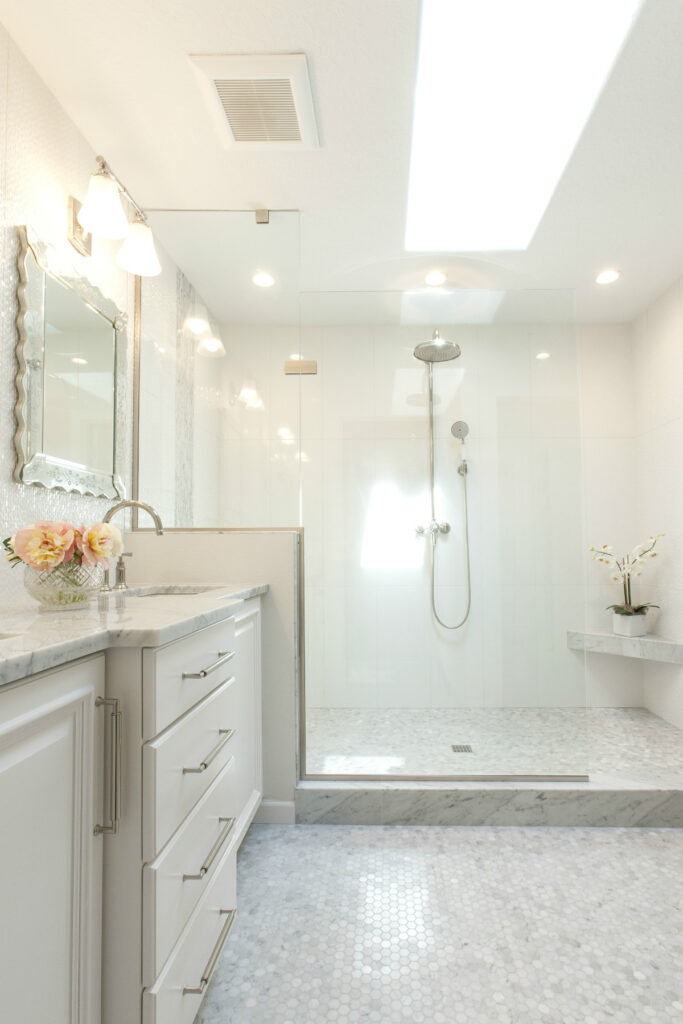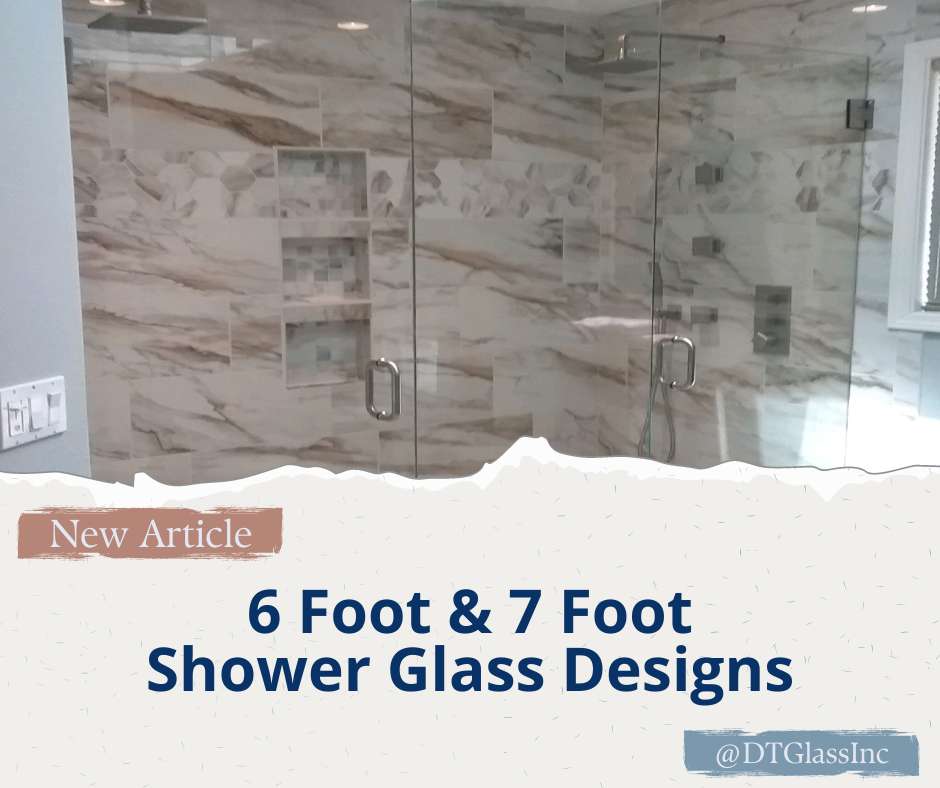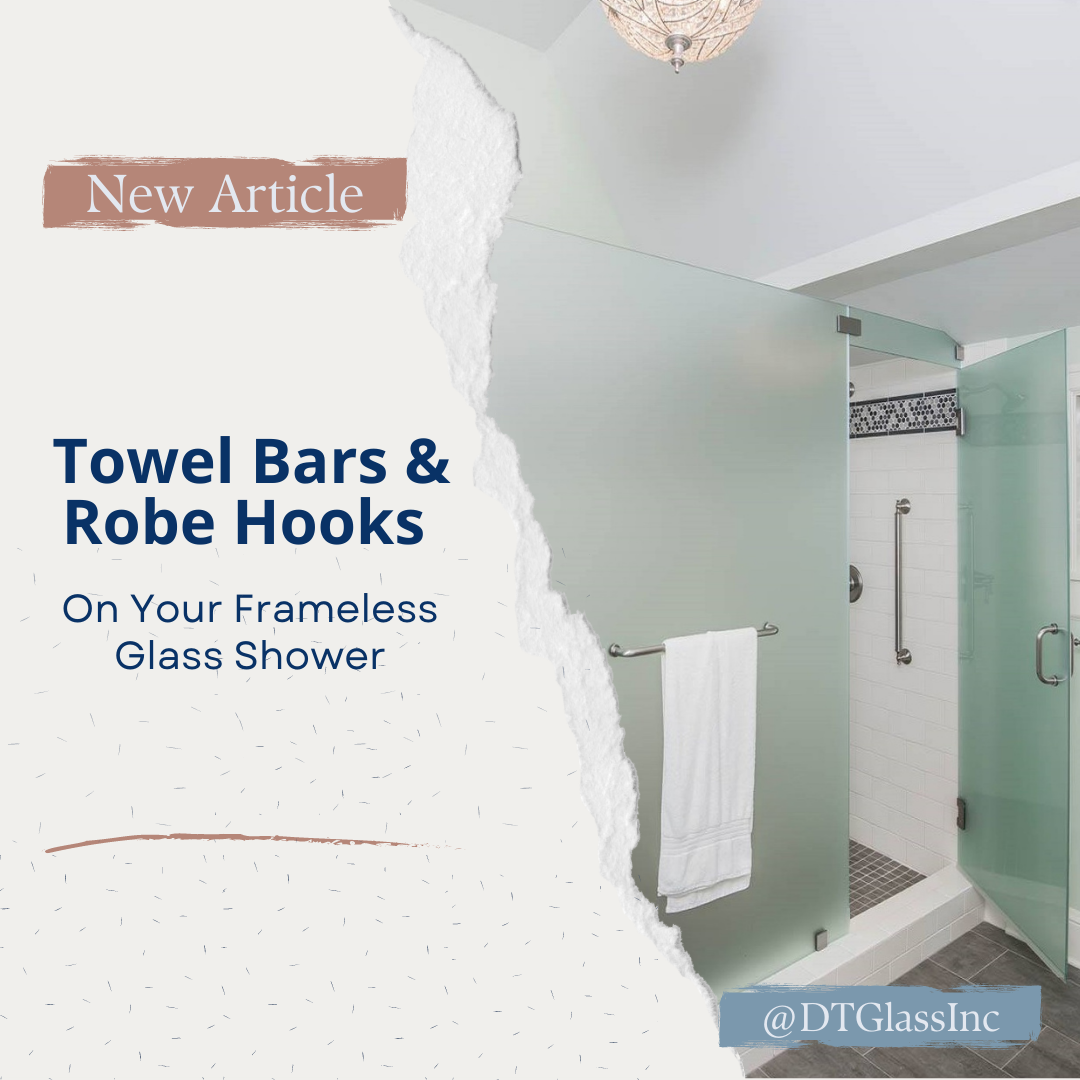
- glass@dtglassinc.com
- (503)-650-6373
WATER MANAGEMENT FOR FRAMELESS GLASS SHOWERS
By Shannon Mckinney – DT Glass, Inc.
What could be more important in a shower design than water management? Done right, the result is enjoying your shower without excess cleanup afterward. Done wrong, the result could be sopping up water, or even water damage and dry rot.
This blog is about managing water, but more importantly it’s about managing expectations. Bathroom and shower design means integrating various systems with an understanding of the individual components: their strengths, weaknesses, capabilities, and limitations.
Integrated systems consist of layers of materials and design that work together to create a well-functioning shower. The systems include:
Water source and force
Shower dimensions
Horizontal surface slope
Waterproof walls
Glass doors

Water source and force: Understanding the water source and force will be the first step in identifying the right systems for containing the water. Standard shower heads direct water about 4 feet from the source with moderate force, rain heads will direct water straight down with less force, and body jets can create enough force to propel the water across the room. Choosing a water barrier that matches the water source means understanding that a single panel of glass in a walk-in shower may be all that’s needed to contain the water from a rain head, but a fully framed and tiled wall might be the best barrier for the water from a body jet.
Shower dimensions: Keeping water inside a 6 foot by 8 foot shower is nearly effortless, but not everyone has the room to create a massive shower space. We do, however, have the ability to take size into account as we incorporate the other systems. As much as you may want body jets and frameless glass in your 3 foot by 3 foot shower, it’s going to lead to regret unless you also recognize that the rest of the bathroom needs to be waterproofed and each shower will be followed by some cleanup. Every choice needs to integrate with the rest.
Horizontal surface slope: Once the water hits a horizontal surface such as a curb, a bench, or the floor, the main method of water control will be the horizontal surface slope. This part of the system works best when it’s able to take advantage of gravity, not try to fight against it. Curbs, benches, and pony walls should be built with a slight angle towards the interior of the shower. The floor should be sloped toward the drain, and the drain should be located away from the shower entrance. Correct slope results in water that carries itself to the drain. Incorrect slope results in water that either puddles in place or must be forcibly blocked from trying to escape.
Waterproof walls: When an area of a shower must include a waterproof barrier, it needs to be a solid wall or fully sealed panel of glass. For example, directly across from a body jet should be a wall or fixed panel, not a door. Also keep in mind that when water hits a wall with force, it may not gently roll down the glass but instead remain a powerful stream that can work its way to the edge of the wall and continue out the door. It’s much better to plan for maximum water protection at the start than to find out at the end of the project that the selected barrier was not enough.

Glass doors: People are sometimes shocked when I tell them that frameless glass showers leak. This shouldn’t be viewed as a design flaw, but as a design trade-off. We hear “I want as little metal as possible” and “I want clean, uninterrupted lines” and we respond with frameless glass. The glass panel portion of the shower won’t leak because it is siliconed in place, but the door will be impossible to completely waterproof, even when we apply seals. If none of the other systems for controlling water are working properly and the glass is the only system for keeping water in the shower, then the best approach is to install semi-frameless glass and the metal framing will hold back most of the water. However, if the other systems are designed well it shouldn’t matter if a frameless door leaks. For example, if we place a door to the side of a standard shower head, the water will spray past the gaps in the glass. If we position glass panels across from body sprays with enough room to deflect the force, then the water can be directed away from gaps. If the curb and floor are sloped correctly, and a sweep is in use, then water should be directed away from the door and not under it. In short, a frameless glass shower will only leak when water is sprayed directly on it, and that doesn’t need to happen in the first place.
Frameless glass showers leak. This shouldn’t be viewed as a design flaw, but as a design trade-off.
The final variable in your shower equation is you. Your presence in the shower and the way you shower will have an impact on the water spray. Will a tall person be using the shower? We might increase the height of the shower glass so that water doesn’t bounce off the person and over the glass. In a walk-in shower, it’s common for the water to hit the person showering and cause overspray to travel in random and unexpected directions. There can also be a very positive impact when your body interrupts the force of a shower spray and keeps it from escaping the shower. Body jets lose a lot of power when they have someone to stand in their way. Finally, when it comes to the shower wand, you’re in control. One common complaint is that water escapes the shower when the shower wand is used to rinse off the glass after showering. There’s not much we can do about water being sprayed directly between the gaps in the glass. “An object in motion stays in motion…”
Before knowing about the rest of the systems we’ve discussed, you might have thought that the shower glass is solely responsible for keeping water in the shower, and that any water escaping is the fault of the glass. The bad news is that shower glass is not 100% watertight. It’s not a fish tank. The good news is that there are multiple systems, in addition to the glass, designed to work together. Each system has its limitations but layering them together in a way that maximizes benefits and minimizes flaws is what creates a beautifully functional shower experience.
It can be tough to balance all the components that go into a shower design. At DT Glass we help homeowners, designers, and contractors find the systems that produce the best shower experience possible. Being involved at the design stage is one of our most valuable services and it’s completely free. It’s how we fulfill our mission of removing the barriers between homeowners and the showers of their dreams. Just call to schedule a consult or visit us in our showroom.




























